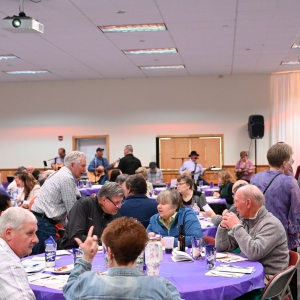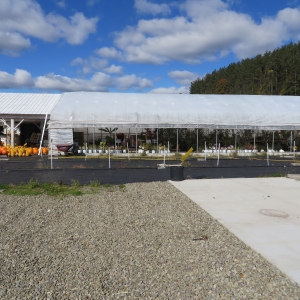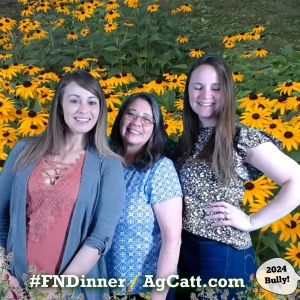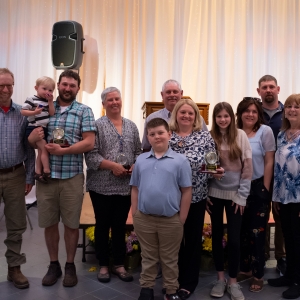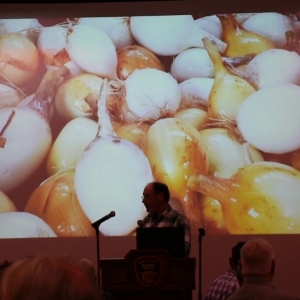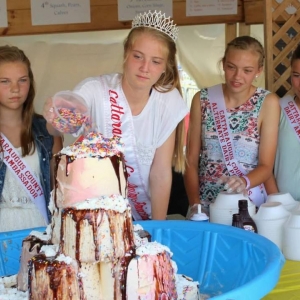Cornell University Cooperative Extension's 23rd Annual Rural Landowner Workshop at Pioneer Central School, County Line Rd Yorkshire, NY on Saturday, March 7, 2015!
Pre-registration is required by Friday, February 20, 2015.
Download the registration form
Sign-ins begins at 8:30 a.m. Refreshments/Exhibits in Cafeteria Auditorium: 9:15-10:15 a.m.
Opening Session – Invasive Species - What Landowners Need to Know About Invasive Species and How to Manage Them Andrea Locke, WNY PRISM Coordinator
We often talk about invasive species in terms of their impacts on the landscape, the harm they cause to our natural systems, biodiversity, and wildlife, their impacts on our economy, and human health concerns. But, when we talk about these issues on such a large scale, we often overlook the direct impacts on private landowners and the lands they most value. This presentation will provide landowners with the information they need to understand invasive species and how they impact their land. We will also cover how to identify common species and provide information on management options. This presentation will focus on terrestrial plant species.
10:30 a.m. - 11:30 a.m. CONCURRENT SESSION I (PICK ONE)
- An introduction to the ecology of northeastern forests - Peter Smallidge, Cornell University Cooperative Extension, Department of Natural Resources. Northeastern forests are interesting and complex interactions of biotic and abiotic components. The interactions and processes that define these interactions constitute the ecology of the forest. Understanding forest ecology, the study of organisms in their environment, helps woodlot owners and managers anticipate how each component contributes to or responds to management activities. An introduction to northeastern forest ecology includes a discussion of landscape history, human activity, natural processes, organismal behavior, and environmental conditions. The emphasis of this introduction is towards those factors related to the regeneration of the forest.
- Tech Tools for Land Stewardship - Michael Jabot, Ph.D. Professor, Science Education US Partner - GLOBE Program Director, Institute for Research in Science Teaching State University of New York at Fredonia. This session will share ways that landowners can easily access data to inform their stewardship decisions. Our focus will be how we can use freely available GIS data sources as well as how we can generate our data.
- Forest Mushroom Cultivation - Don Gasiewicz, Owner/Operator Toad Song Mushrooms, CCE Wyoming County. Utilize low value and cull trees to grow gourmet mushrooms. Whether for home consumption or profit, small diameter trees can be used as a low cost substrate, while producing high value mushrooms. Learn the types of mushrooms you can grow, which tree species you can use for mushrooms, inoculation techniques, site considerations, fruiting your logs, and some simple marketing strategies.
- How to Tell if Your Woods are Affected by Deer: A Visual Assessment Tool - Kristi Sullivan, Cornell Dept. of Natural Resources. Deer browse on trees and other plants in our woodlands and by doing so can change the types of plants that grow, as well as the overall structure, or “look” of the forest. To the untrained eye the forest may appear to be healthy, but there are clues you can use to tell if deer are affecting their own habitat, habitat of other wildlife, and plant diversity. Often these clues can be uncovered just by looking. This presentation will take you on a visual tour of some woodlands and show what to look for on your own land.
LUNCH 11:30 a.m. – 12:45 p.m.
12:45 p.m. - 1:45 p.m. CONCURRENT SESSION II (PICK ONE)
- Thinning practices to improve forest growth and tree vigor. Presented by Peter Smallidge, Cornell University Cooperative Extension. Thinning is the process of selecting and removing some trees to improve the growth and vigor of the residual trees. The benefits of thinning are well documented, but selecting the correct trees can have a profound influence on the success of the thinning treatment. This presentation will review some of the scientific literature that describes how trees will respond to thinning, and what owners and managers might expect as a growth response. Different ways to select the location and arrangement of trees will be reviewed. The potential risks of thinning will be discussed.
- Your Woodland as Wildlife Habitat and a Source of Biodiversity Kristi Sullivan, Cornell Dept. of Natural Resources. Woodlot owners are drawn to wildlife, wildlife they can see and knowing they are providing useful habitat. They say ‘beauty is in the eye of the beholder’, and that certainly is the case when it comes to wildlife habitat. Animals, unlike people, tend to prefer ‘messy’ surroundings that provide good places to hide and abundant food items. Woodland owners and forest managers can play active roles in assuring woodland have a variety of habitats to support a diversity of wildlife species. Learn about the steps you can take to create better wildlife habitat and increase biodiversity, and how looking at your woodland as part of the surrounding landscape can help you make important management decisions.
- Safe Chainsaw Handling and Felling Techniques: James Carrabba, Agricultural Safety Specialist New York Center for Agricultural Medicine and Health. This presentation will give a general overview of safe chainsaw handling and tree felling techniques. A general overview of basic chainsaw safety principles will be discussed. Proper tree felling techniques will be covered. The proper types of Personal Protective Equipment (PPE) needed to work safely in woodlots will be presented. The presentation will review logging related injury statistics that have occurred in New York. Basic first aid measures will briefly be covered.
- Food Plot Preparation and Forage Selection - Aaron Santangelo, Community Educator CCE Allegany County. Developing and maintaining food plots can be a costly endeavor. Starting out with an understanding of soils and the right planting information can be both cost effective and enhance the level of success to meet you goals. Learn how to match forage selection to the animal species you want to attract while preparing site forage can productively grow in.
1:55 p.m. - 2:55 p.m. CONCURRENT SESSION III (PICK ONE)
- Are You Growing Your Best Timber? Peter Smallidge, Cornell University Cooperative Extension, Department of Natural Resources. For some woodland owners timber management is a high priority of ownership, and most owners recognize there is some value in their timber. Ultimately, most woodlots are eventually harvested. Many activities by woodland owners influence timber volume and value. Timber is an asset to the owner, and can accumulate significant value if managed appropriately. This session will cover some of the core strategies to increase the volume and value of timber on private woodlands and will discuss a new initiative called the Timber Growing Contest. The Timber Growing Contest is a friendly competition where woodland owners throughout the Northeast learn to measure the growth of their forest trees to learn more about timber volume and value. Foresters would often be involved in the contest with their clients to assist with the measurements and management. The Timber Growing Contest is part of the Restore New York Woodlands Initiative and is coordinated by the NY Forest Owners Association and Cornell’s Forest Connect program.
- Respiratory Protection to Reduce Pesticide Exposures: James Carrabba, Agricultural Safety Specialist New York Center for Agricultural Medicine and Health. This presentation will give a general overview of respirators and respiratory protection that may be required to be used when applying pesticides. The presentation will discuss respiratory exposures and respiratory protection to prevent those exposures. The hierarchy of controls will be covered, explaining why it is most effective to start with engineering controls first, next implement administrative controls and finally relying on PPE for protection. The different types of respirators available will be explained. Selection of appropriate respirators will be covered. The OSHA regulation 1910.134 governing respirators use and how it applies to agriculture will be covered. Medical clearance and fit testing procedures will be explained. New regulations affecting respirator use listed in the proposed changes to the EPA Worker Protection Standard will also be discussed. Information on cleaning and proper storing of respirators will also be covered.
- "Organics-Back to The Future" Creative Food Plotting for Deer Hunters: David VanEarden, High School Biology Teacher. This presentation discusses the connection between humans, the farm and the deer we hunt and eat. An avid hunter and fisherman, David will share his experience with food plots for deer and turkey, and the work he has done to improve his farm for livestock while enhancing the environment for wildlife.
- USDA/NRCS Conservation Farm Bill Program Opportunities: Shanna Shaw, NRCS Area Biologist. An overview of forestry, grassland, shrubland, and wetland program incentives available to promote forest stewardship and wildlife habitat management. This session will provide a review of the voluntary conservation programs that provide financial and technical assistance to landowners. Photos of current and past projects will be included.
- Learn to Bird Join Buffalo Audubon Naturalist Tom Kerr and learn how to spot a field mark, identify birds by using a field guide, and how to properly use binoculars. Binoculars will be provided.
3:00 PM - NYFOA Membership Drawing – Cafeteria
Take Note:
No Refunds No Walk-Ins Please.
PLEASE NOTE: All Pioneer District Buildings and Grounds are drug and tobacco free areas; including facilities, fields, parking lots, etc. No Smoking is allowed in the facilities or on the grounds.
See Directions Below:
From the North: Take the 400 Expressway to Rte. 16 South to Yorkshire. Turn left onto Rte. 39 then right onto County Line Road. Pioneer Central School is 1/4 mile on the right.
From the South: Take the Southern Tier Expressway 86 (formerly 17) to Rte. 16, travel north to Yorkshire. Turn right onto Rte. 39 then right onto County Line Road. Pioneer Central School is 1/4 mile on the right.
From the East: Take Exit 8 on Interstate 390 to Rte. 20A. Travel West to Rte. 39 and turn left to Yorkshire. Turn left onto County Line Road. Pioneer Central School is 1/4 mile on the right.
Questions?
For more information or to register contact Cornell University Cooperative Extension at 585-268-7644 ext. 18 or visit this event's page at: http://allegany-cattaraugus.cce.cornell.edu/events/2015/03/07/rural-land...



